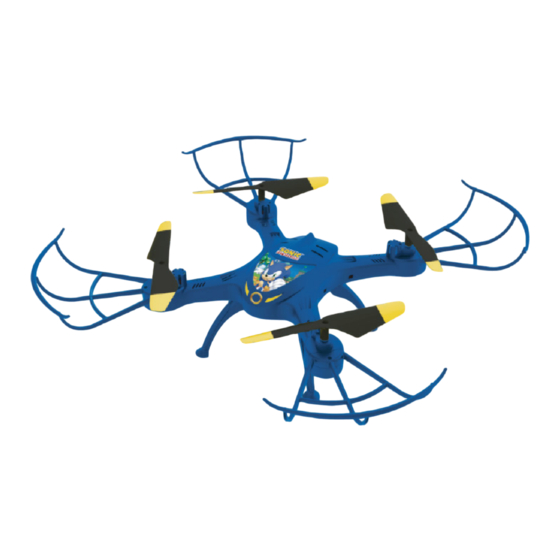
Table of Contents
Advertisement
Quick Links
Advertisement
Table of Contents

Summary of Contents for Sega SONIC DRC188
- Page 1 USER’S MANUAL ITEM: DRC188...
-
Page 2: Important Safety Precautions
1. Important Safety Precautions When using your Sonic the Hedgehog™ Sky Racer Drone, basic safety precautions should always be followed, including the following: 1. Do not allow children or the infirm to operate your drone without adult supervision. For safety purposes, only allow experienced pilots aged 14 and up fly your drone. -
Page 3: Package Contents
3. Introduction Thank you for purchasing the Sonic the Hedgehog™ Sky Racer Drone, item DRC188. The included remote controlled aircraft is designed specifically for outdoor flying. In order to get the best possible results, please read this user’s manual carefully before using. In addition, be sure to keep this manual in a safe place for future reference. - Page 4 5. A Quick Look at Your Remote Control 2. Camera 3. Video 8. Power Indicator 1. Speed 4. Flip Button 7. One Key Return 6. Headless Mode 5. Left Control Stick 11. Right Control Stick 12. Fine Tuning Key 14. Power Button 9.
- Page 5 6. Inserting Batteries Into Your Remote Control Use a screwdriver (included) to open up the battery compartment located on the rear of your remote control. Insert 3 AA 1.5V batteries(not included), making sure that the batteries are inserted with the correct polarity (+,-) as displayed in the battery compartment.
- Page 6 7. Charging Your Drone’s Battery Open the drone’s battery compartment and remove the battery. Connect the battery to the included charger. Then plug the charger into a USB charging adapter (not included). For best results, use a 5V, 1-2A charger to charge the battery. The charger has an LED light indicator.
-
Page 7: Installing Camera
8. Installing Landing Legs/Landing Guards Install the landing legs (included) to the bottom of your drone. There are sockets at the bottom of the drone to attach the landing legs. Insert the landing legs as shown in the illustration below. To secure the landing legs with the screws . 9. - Page 8 10. Synchronizing Your Remote and Drone To power on your drone, make sure that the battery is inserted and fully charged. Slide the power switch located at the rear of the drone to the ’on’ position to turn your drone on. Follow the steps below in order to synchronize your drone and remote control for flight.
-
Page 9: Flying Your Drone
12. Flying Your Drone Pre-Flight Preparation If you have never used a drone before and you are not an experienced pilot, make sure to read these instructions carefully before flying. Get familiar with all of the controls. If necessary, read through these instructions many times and practice handling the remote control until you feel completely comfortable and ready. -
Page 10: Speed Adjustment
13. Speed Adjustment Your drone has three speed settings (Low, Medium, High). Press the Speed button on the top left side of your remote control to adjust the speed at which your drone flies. 14. 3-D Flips Your drone can perform 3-D flips using the flip button and the directional control stick. To perform a flip, make sure your drone is at least 3 meters above ground, then press the flip button while pushing the directional control stick i one direction. -
Page 11: One Key Return
16. One Key Return One Key Return allows your drone to return to its take-off coordinates with the push of a button. To activate, press the One Key Return button and use the left control sick to adjust the altitude of your drone. Once your aircraft is within visible and controllable range, push the directional lever in any direction to exit return mode. -
Page 12: Fcc Compliance Statement
FCC Compliance Statement Changes or modifications not expressly approved by the party responsible for compliance could void the user’s authority to operate the equipment. This device complies with Part 15 of the FCC Rules. Operation is subject to the following two conditions: (1) this device may not cause harmful interference, and (2) this device must accept any interference received, including interference that may cause undesired operation.
Need help?
Do you have a question about the SONIC DRC188 and is the answer not in the manual?
Questions and answers